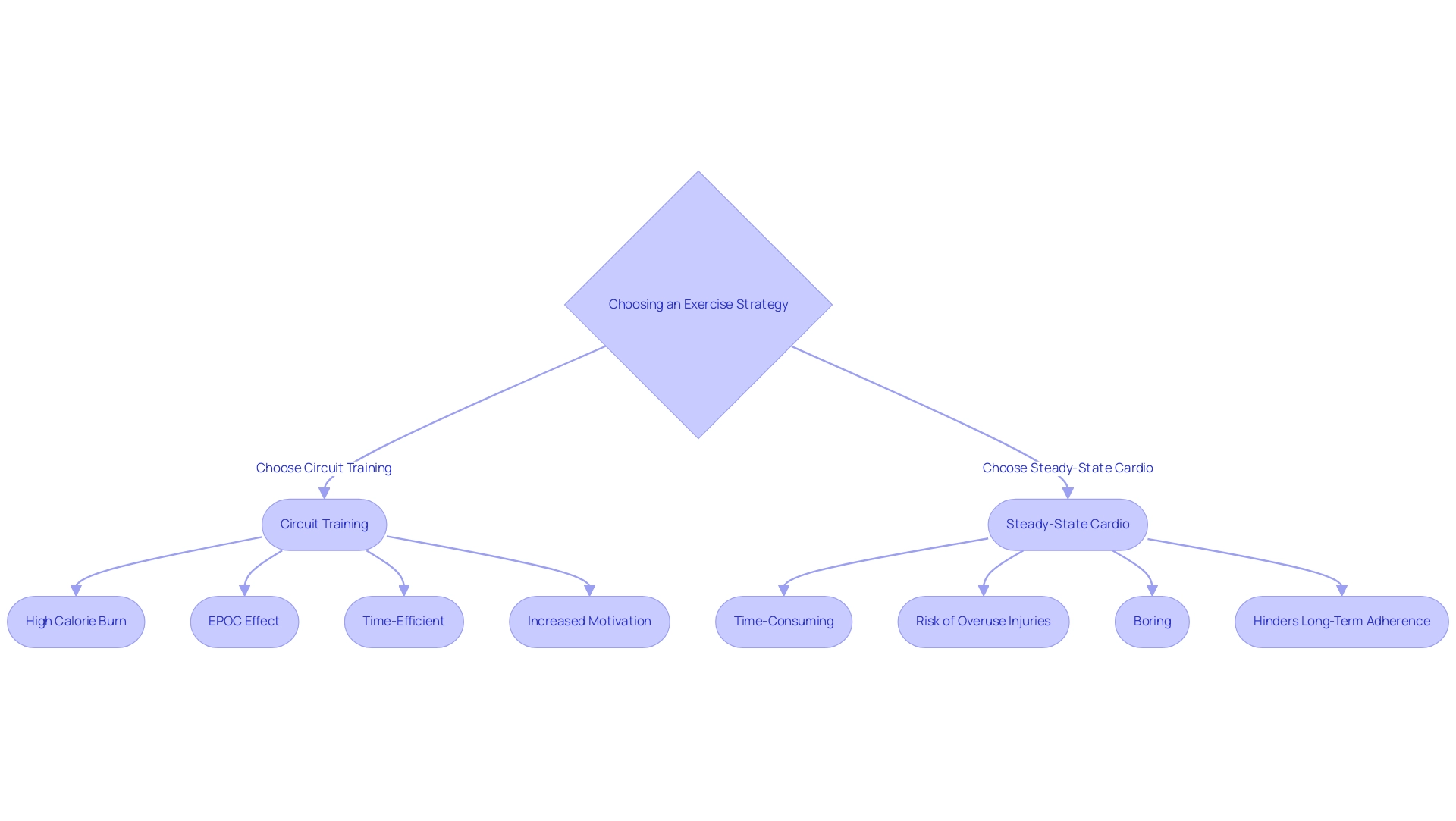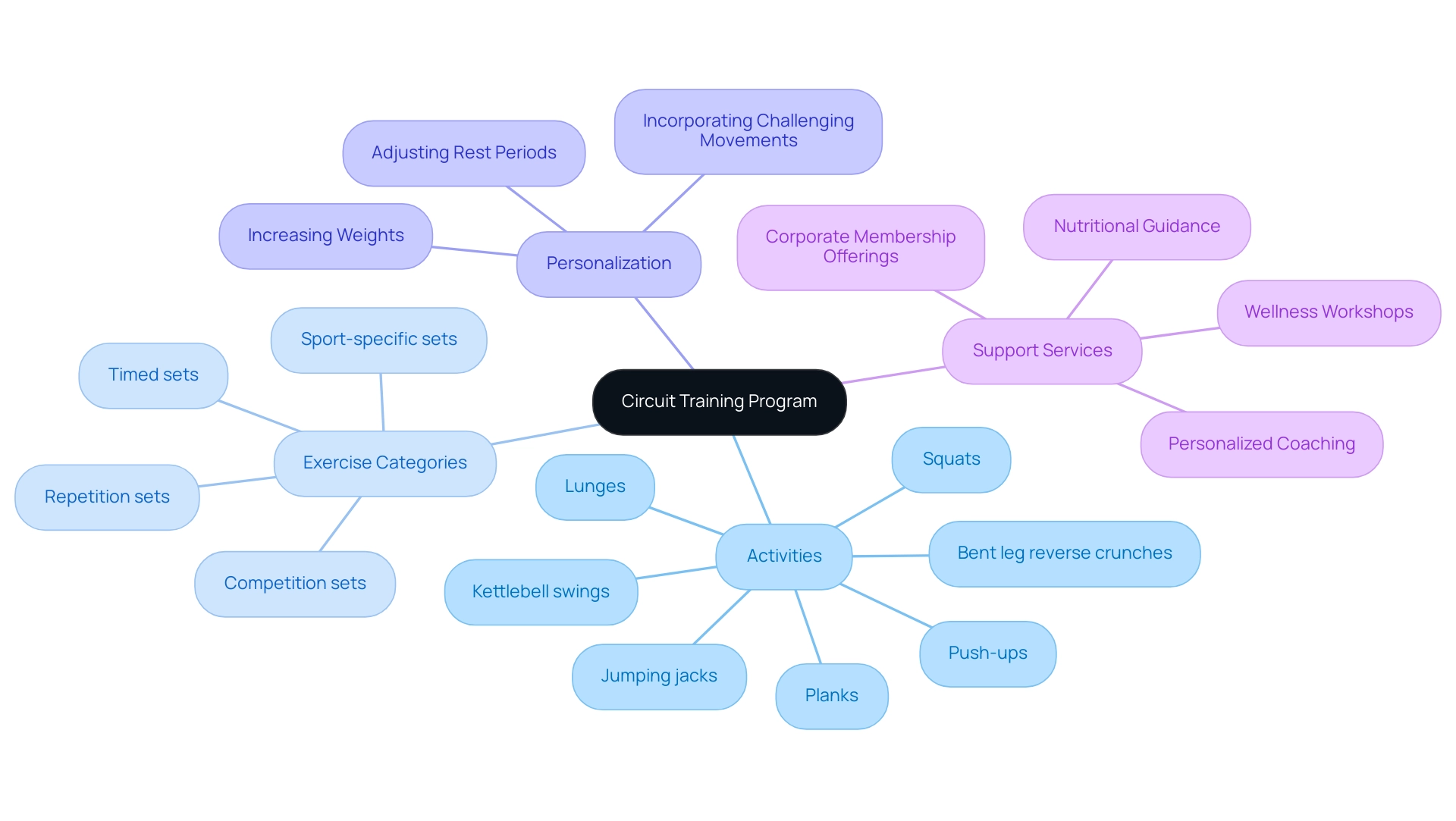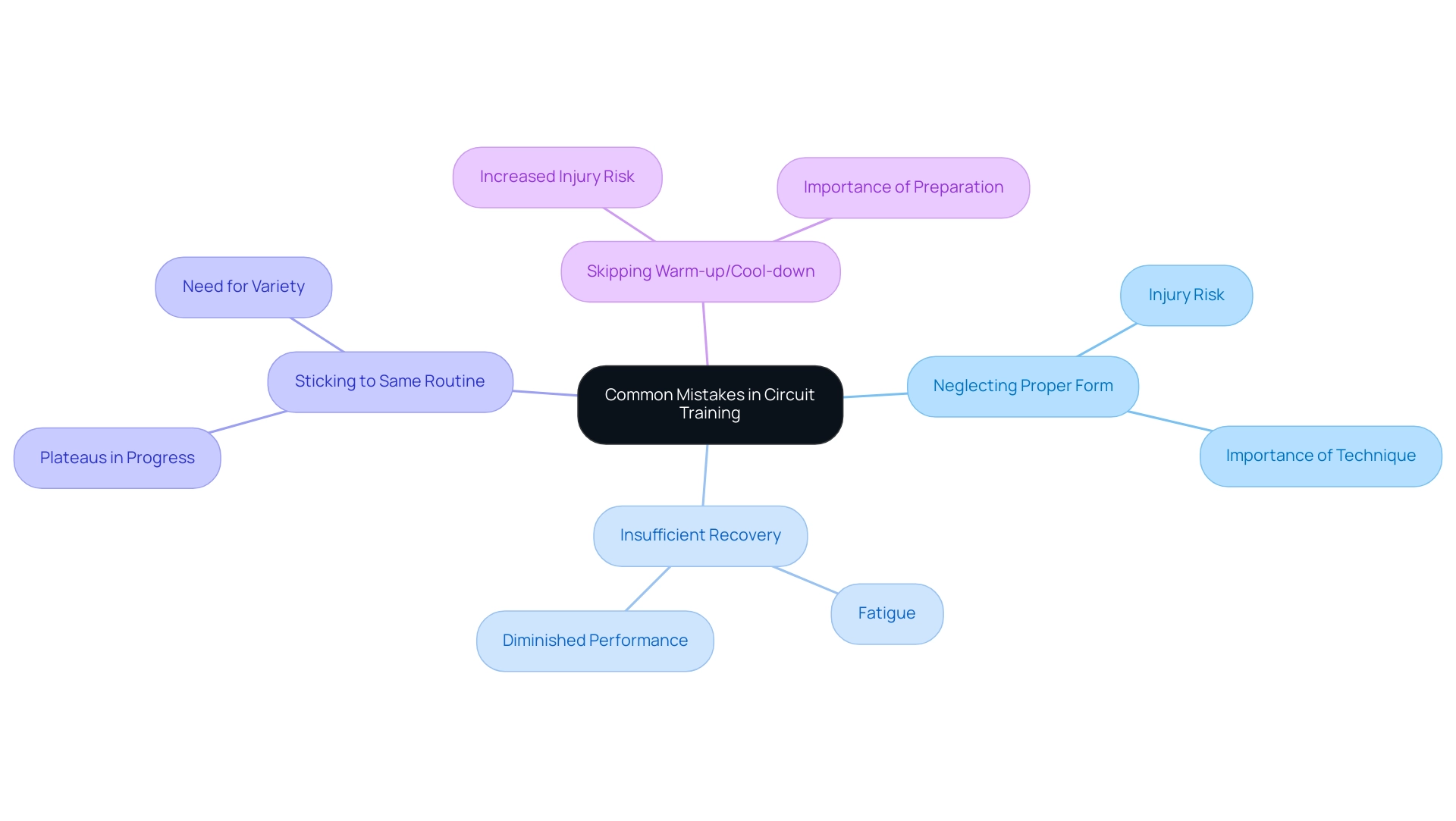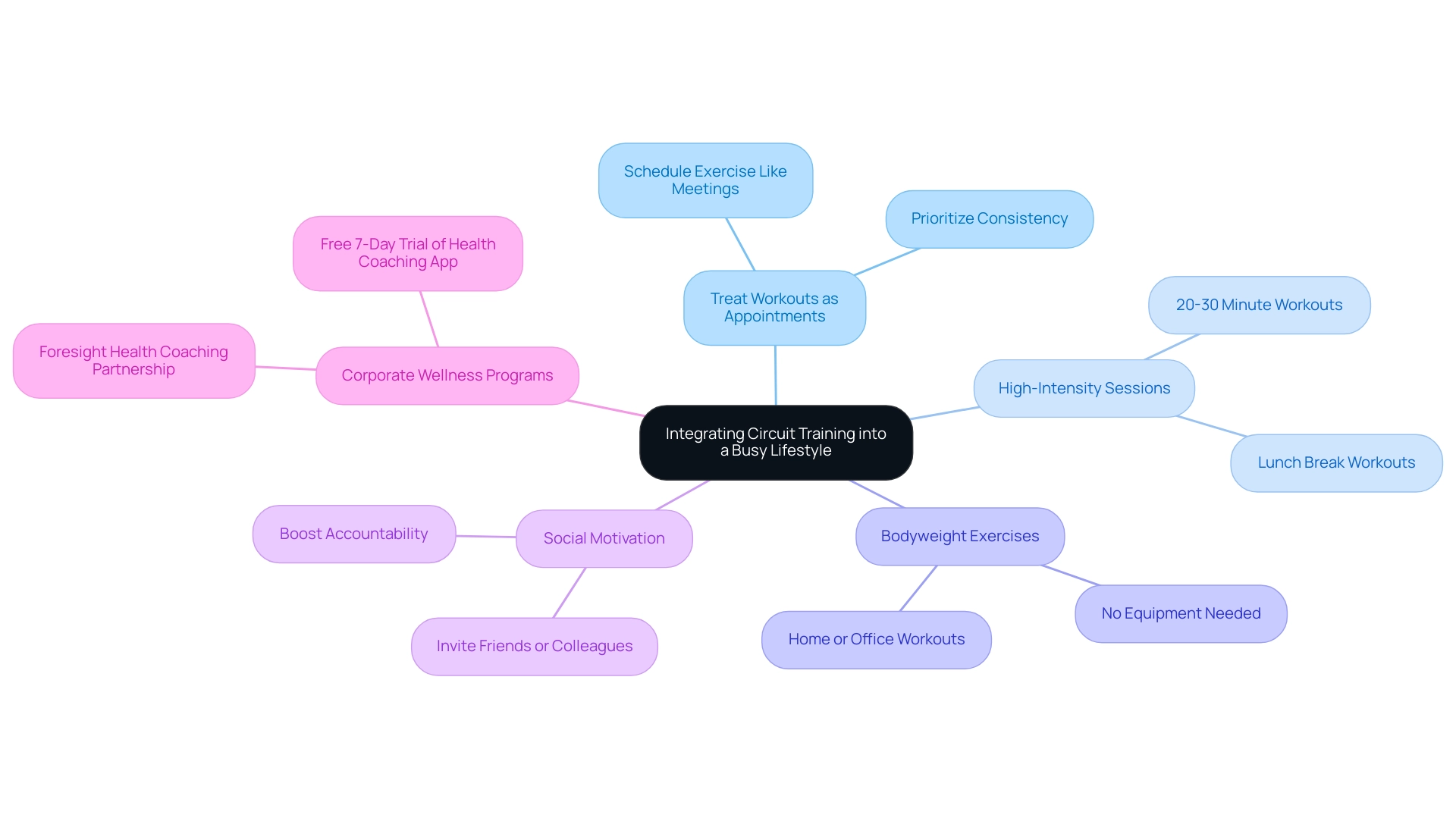Overview
Circuit training for weight loss is an effective fitness method that combines strength training and aerobic exercises in a time-efficient format, promoting significant calorie burn and improved cardiovascular health. The article supports this by detailing how the structure of circuit training, with minimal rest and varied exercises, enhances motivation and adherence while maximizing workout efficiency, making it suitable for individuals with busy lifestyles.
Introduction
In a world where time is a precious commodity, circuit training emerges as a dynamic solution for individuals seeking to enhance their fitness while juggling busy schedules. This innovative workout method combines strength and cardiovascular exercises into efficient sessions, enabling participants to achieve remarkable results in a fraction of the time compared to traditional workouts.
With its adaptability to various fitness levels and the ability to engage multiple muscle groups, circuit training not only promotes physical health but also fosters a culture of wellness within organizations. As teams strive for improved well-being and productivity, embracing this approach can pave the way for transformative changes, making it an essential component of any comprehensive health initiative.
Understanding Circuit Training: A Comprehensive Definition
Circuit training for weight loss is a groundbreaking method for body fitness that efficiently combines strength development with aerobic activity, providing a thorough workout in one session. This instructional approach generally includes a sequence of 6 to 10 exercises in circuit training for weight loss, focusing on different muscle groups with little rest in between, which not only improves muscular endurance but also considerably increases cardiovascular health. The time-effective aspect of circuit training for weight loss makes these exercises attractive to busy people, enabling them to optimize their workout in a brief duration.
The adaptability of circuit training for weight loss is one of its major advantages; it can be tailored for diverse activity levels and can include various types of resistance, such as body weight, resistance bands, free weights, or machines. This adaptability ensures that everyone, from beginners to advanced athletes, can benefit from circuit training for weight loss. Recent studies demonstrate that participants involved in interval workouts have experienced significant enhancements in their fitness levels, with leg press strength showing notable increases, indicated by a standardized mean difference (SMD) of 1.83 after as few as 21 to 30 sessions.
Furthermore, for optimal strength improvements, it is suggested that untrained individuals engage in a series of workouts at a frequency of 3 sessions per week.
A notable case study, conducted by Pyka et al. in 1994, involved older adults averaging 68.2 years of age who participated in a randomized controlled trial. Over 12 weeks, concentrating on 65-75% of the one-repetition maximum (1RM) for a total of 52 sessions, participants showed notable enhancements in upper limb push, upper limb pull, knee function, and hip function.
As Dr. Angela M. Bell, MD, FACP, aptly puts it,
Here's all you need to know about REDs if you follow a demanding workout routine, whether as a professional athlete or as an amateur competitor.
This emphasizes the importance of including organized workouts such as interval exercises into daily habits. With intervention periods in studies ranging from 8 to 56 weeks, there’s no better time for HR Benefits Managers to prioritize such effective strategies that can lead to accelerated weight loss and enhanced overall well-being for their teams.
By integrating these workout routines with a comprehensive wellness coaching app that offers personalized programming, nutrition guidance, and direct coach communication, organizations can streamline their health initiatives, making it easier for employees to achieve their wellness goals efficiently. Testimonials from users like Sarah, who lost 15 pounds in 3 months by engaging in circuit training for weight loss through the app's personalized routines, demonstrate the app's effectiveness. By providing all the tools and resources needed in one place, the app eliminates the hassle of searching for different wellness programs, making it an essential resource for any health-focused organization.

The Weight Loss Benefits of Circuit Training: Why It Works
Circuit training for weight loss is recognized as a powerhouse strategy for effective weight loss, and here's why. This approach seamlessly integrates high-intensity exercises with minimal rest, elevating the heart rate and maximizing calorie expenditure during and after workouts through a phenomenon known as excess post-exercise oxygen consumption (EPOC). Studies show that interval workouts can incinerate up to 30% more calories in a shorter duration than conventional steady-state cardio.
For example, participants involved in workout sessions can attain calorie-burning outcomes that are not only remarkable but also time-efficient. Moreover, the diverse character of exercise routines keeps individuals involved and inspired, effectively addressing workout monotony that often results in dropout. As mentioned by fitness specialist Paige Waehner, "The thrill of interval exercise can change a monotonous workout into an energetic challenge."
Furthermore, research indicates that interval workouts can result in an EPOC effect lasting up to 24 hours after exercise, greatly enhancing total calorie expenditure. This approach also helps build lean muscle mass, which further boosts metabolism, allowing for enhanced calorie burning even at rest. In contrast, relying solely on steady-state cardio can lead to weight-loss plateaus, as highlighted in the case study titled 'Cons of Steady State Training.'
This study points out that:
- Steady-state exercise can be time-consuming.
- It can lead to overuse injuries.
- It may feel boring.
- It may hinder long-term adherence.
By integrating circuit training for weight loss into a consistent exercise regimen, individuals can not only attain significant weight loss outcomes but also improve their overall wellness levels, making it a tactical option for those seeking to boost their health and well-being.

Designing an Effective Circuit Training Program
Creating a successful training regimen that incorporates circuit training for weight loss entails choosing a varied selection of activities that target several muscle groups, such as the upper body, lower body, core, and cardiovascular systems. At Foresight Health Coaching, we provide tailored programs that not only focus on physical fitness but also integrate nutritional guidance and wellness workshops, ensuring a holistic approach to health. Target a routine that includes circuit training for weight loss, consisting of 6 to 10 activities carried out in succession.
For instance, a well-rounded routine could incorporate:
- Push-ups
- Squats
- Jumping jacks
- Lunges
- Planks
- Kettlebell swings
Along with a simple total body step-up workout that includes 10 reps of bent leg reverse crunches. Each exercise should be timed for 30 to 60 seconds, followed by a brief rest period of 15 to 30 seconds. Completing the circuit training for weight loss 2 to 4 times can be adjusted based on personal activity levels.
Prioritizing a proper warm-up before starting and a cool-down afterward is crucial to prevent injuries. As activity levels improve, participants can modify the intensity of their circuit training for weight loss by adjusting rest periods, increasing weights, or incorporating more challenging movements. This adaptability not only encourages progress at a personal pace but also stimulates motivation and dedication to long-term health goals.
Foresight’s app-based delivery of personalized coaching ensures that each participant receives continuous support and guidance tailored to their specific needs, fostering community engagement among users. Additionally, our corporate membership offerings include in-person wellness talks and nutrition services, designed to optimize workplace health and productivity. There are four primary categories of exercise routines:
- Repetition sets
- Timed sets
- Competition sets
- Sport-specific sets
Each type enables individuals to tailor their workouts according to personal objectives, whether for overall health or specific sports performance. According to Ani, the Vice President of Fitness at Chuze Fitness, utilizing state-of-the-art facilities and certified trainers can significantly enhance participants' experiences. With Foresight Health Coaching, you can develop efficient workout plans that result in successful and sustainable fitness journeys, while prioritizing your team's well-being.
To learn more about how our comprehensive services can benefit your organization, please reach out to us directly.

Common Mistakes to Avoid in Circuit Training
Participating in workout sessions provides excellent advantages, but it’s crucial to avoid typical mistakes that can obstruct advancement and elevate the likelihood of injuries. A significant mistake often made is neglecting proper form during exercises. Prioritizing technique over speed or intensity is crucial, as improper form can lead to injuries, particularly in high-intensity settings.
Research indicates that while 70% of individuals engage in weightlifting without specialized supervision, this lack of guidance can exacerbate injury risks. Significantly, participants who practiced an alternative sport reported injuries at a rate of 15.5%, compared to 11.2% for those who solely participated in weightlifting, emphasizing the importance of maintaining proper form and recovery in training. As noted by fitness expert Timothy Tsin Jien Cheng:
These findings should aid in the evidence-based participation in FT/CF and provide better understanding of the risks involved.
Furthermore, allowing insufficient recovery time between sessions can lead to fatigue and diminished performance; thus, it’s vital to listen to your body and rest as needed. Sticking to the same routine for too long can also lead to plateaus, so diversify your practices regularly by adding new exercises or increasing intensity. The study by Weisenthal et al. on injury rates and patterns among CrossFit athletes reinforces the importance of proper form and injury prevention strategies.
Finally, don't overlook the importance of warm-up and cool-down routines; neglecting these can greatly increase the risk of injury. By implementing these strategies, you can cultivate a safer and more effective learning environment, ultimately enhancing performance and well-being.
Additionally, a recent case study titled 'Strengths and Limitations of the Study' conducted in the Taif region provides valuable insights into sports-related injuries, emphasizing the need for awareness and prevention measures.

Integrating Circuit Training into a Busy Lifestyle
Embracing interval training as part of a busy lifestyle is not only feasible but can be transformative with thoughtful planning and creativity. One impactful strategy is to treat your workouts as essential appointments—block out time for exercise just as you would for a crucial meeting. Choose brief, high-intensity workout sessions that can be finished in only 20 to 30 minutes, making them perfect for lunch breaks or after work.
Remarkably, individuals in the workout group experienced a significant reduction in TG, with a value of 8.120, highlighting the effectiveness of this method. Bodyweight exercises are particularly beneficial as they require no equipment, allowing workouts to be conducted at home or even in the office. Moreover, inviting friends or colleagues to join in on circuit training for weight loss can significantly boost motivation and accountability.
Remember, consistency is paramount; aim for at least 2 to 3 sessions per week of circuit training for weight loss to witness substantial progress on your journey. Furthermore, by investing in Foresight Health Coaching’s corporate partnership, which includes tailored health programs and ongoing support for your team, you can nurture a stronger team culture and enhance employee wellness. To get started, contact us today to schedule a consultation and learn more about how our partnership can benefit your organization.
Additionally, take advantage of our free 7-day trial promotion for our transformative health coaching app, which offers personalized features to support your wellness goals and set a powerful example for your team, reinforcing a culture of well-being and productivity.

Conclusion
Embracing circuit training offers a powerful solution for those navigating the complexities of busy schedules while striving to enhance their fitness. This dynamic workout method merges strength and cardiovascular exercises into efficient sessions that yield impressive results in a fraction of the time compared to traditional workouts. Its adaptability to different fitness levels, impressive weight loss potential, and ability to engage multiple muscle groups make circuit training an invaluable asset for individuals and organizations alike.
By integrating circuit training into wellness initiatives, organizations can foster a culture of health that not only improves employee well-being but also boosts productivity. With the right program design, personalized coaching, and a supportive community, participants can stay motivated and committed to their fitness journeys. It is crucial to avoid common pitfalls, such as neglecting proper form and insufficient recovery, to ensure a safe and effective training experience.
Ultimately, circuit training is more than just a workout; it is a transformative approach that empowers individuals to prioritize their health amidst their busy lives. By taking action and implementing these strategies, HR Benefits Managers can champion their teams' wellness, creating a positive ripple effect that enhances both personal and professional growth. Now is the moment to embrace circuit training and unlock the potential for a healthier, more vibrant workplace.
Frequently Asked Questions
What is circuit training for weight loss?
Circuit training for weight loss is a fitness method that combines strength development with aerobic activity, offering a comprehensive workout in a single session. It typically involves a sequence of 6 to 10 exercises targeting different muscle groups with minimal rest between them.
What are the benefits of circuit training for weight loss?
The benefits include improved muscular endurance, enhanced cardiovascular health, and efficient workouts that save time, making it suitable for busy individuals. It can also be tailored for various fitness levels and includes different types of resistance.
How does circuit training impact cardiovascular health?
Circuit training elevates the heart rate and maximizes calorie expenditure during and after workouts through the excess post-exercise oxygen consumption (EPOC) effect, which can lead to continued calorie burning for up to 24 hours post-exercise.
Can circuit training be adapted for different fitness levels?
Yes, circuit training is highly adaptable and can be modified for beginners to advanced athletes, using various forms of resistance such as body weight, resistance bands, free weights, or machines.
How often should untrained individuals engage in circuit training for optimal strength improvements?
It is suggested that untrained individuals participate in circuit training sessions three times a week for optimal strength improvements.
What evidence supports the effectiveness of circuit training?
Studies have shown significant improvements in fitness levels among participants, including a notable increase in leg press strength after 21 to 30 sessions. Additionally, a case study involving older adults demonstrated improvements in upper limb and lower limb functions after 12 weeks of circuit training.
How does circuit training compare to steady-state cardio?
Circuit training can burn up to 30% more calories in a shorter time compared to conventional steady-state cardio. It also helps build lean muscle mass, which boosts metabolism and calorie burning at rest, while steady-state cardio may lead to weight-loss plateaus.
What role does technology play in circuit training for weight loss?
Integrating circuit training with a wellness coaching app can enhance the experience by providing personalized programming, nutrition guidance, and direct communication with coaches, streamlining health initiatives for users.
Are there any testimonials regarding the effectiveness of circuit training?
Yes, testimonials, such as one from a user named Sarah, indicate success with circuit training, as she lost 15 pounds in three months by following personalized routines through a wellness app.




